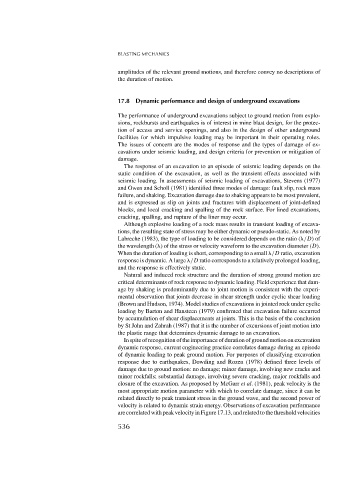Page 554 - Rock Mechanics For Underground Mining
P. 554
BLASTING MECHANICS
amplitudes of the relevant ground motions, and therefore convey no descriptions of
the duration of motion.
17.8 Dynamic performance and design of underground excavations
The performance of underground excavations subject to ground motion from explo-
sions, rockbursts and earthquakes is of interest in mine blast design, for the protec-
tion of access and service openings, and also in the design of other underground
facilities for which impulsive loading may be important in their operating roles.
The issues of concern are the modes of response and the types of damage of ex-
cavations under seismic loading, and design criteria for prevention or mitigation of
damage.
The response of an excavation to an episode of seismic loading depends on the
static condition of the excavation, as well as the transient effects associated with
seismic loading. In assessments of seismic loading of excavations, Stevens (1977)
and Owen and Scholl (1981) identified three modes of damage: fault slip, rock mass
failure, and shaking. Excavation damage due to shaking appears to be most prevalent,
and is expressed as slip on joints and fractures with displacement of joint-defined
blocks, and local cracking and spalling of the rock surface. For lined excavations,
cracking, spalling, and rupture of the liner may occur.
Although explosive loading of a rock mass results in transient loading of excava-
tions, the resulting state of stress may be either dynamic or pseudo-static. As noted by
Labreche (1983), the type of loading to be considered depends on the ratio ( /D)of
the wavelength ( ) of the stress or velocity waveform to the excavation diameter (D).
When the duration of loading is short, corresponding to a small /D ratio, excavation
response is dynamic. A large /D ratio corresponds to a relatively prolonged loading,
and the response is effectively static.
Natural and induced rock structure and the duration of strong ground motion are
critical determinants of rock response to dynamic loading. Field experience that dam-
age by shaking is predominantly due to joint motion is consistent with the experi-
mental observation that joints decrease in shear strength under cyclic shear loading
(Brown and Hudson, 1974). Model studies of excavations in jointed rock under cyclic
loading by Barton and Hansteen (1979) confirmed that excavation failure occurred
by accumulation of shear displacements at joints. This is the basis of the conclusion
by St John and Zahrah (1987) that it is the number of excursions of joint motion into
the plastic range that determines dynamic damage to an excavation.
In spite of recognition of the importance of duration of ground motion on excavation
dynamic response, current engineering practice correlates damage during an episode
of dynamic loading to peak ground motion. For purposes of classifying excavation
response due to earthquakes, Dowding and Rozen (1978) defined three levels of
damage due to ground motion: no damage; minor damage, involving new cracks and
minor rockfalls; substantial damage, involving severe cracking, major rockfalls and
closure of the excavation. As proposed by McGarr et al. (1981), peak velocity is the
most appropriate motion parameter with which to correlate damage, since it can be
related directly to peak transient stress in the ground wave, and the second power of
velocity is related to dynamic strain energy. Observations of excavation performance
arecorrelatedwithpeakvelocityinFigure17.13,andrelatedtothethresholdvelocities
536

